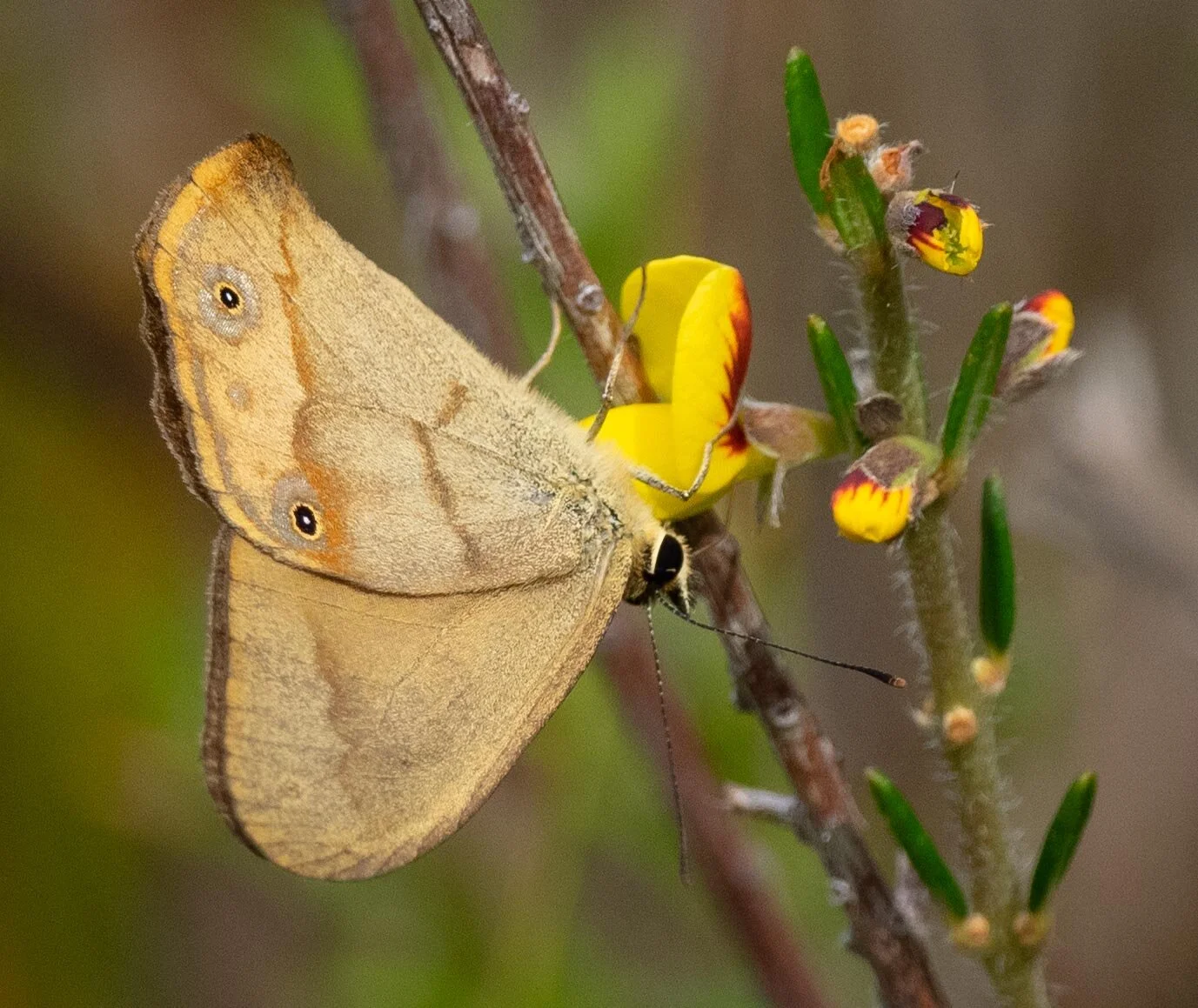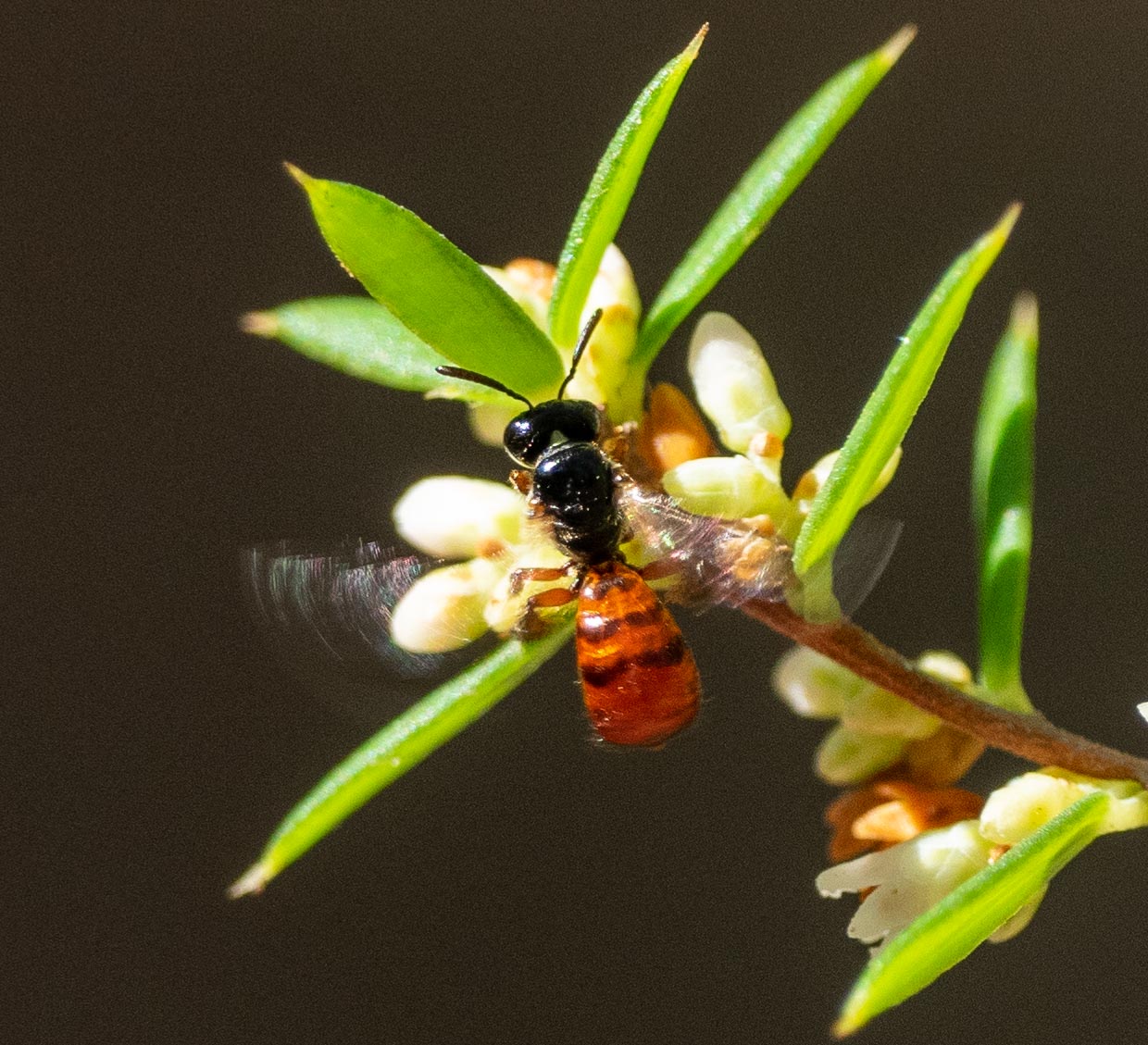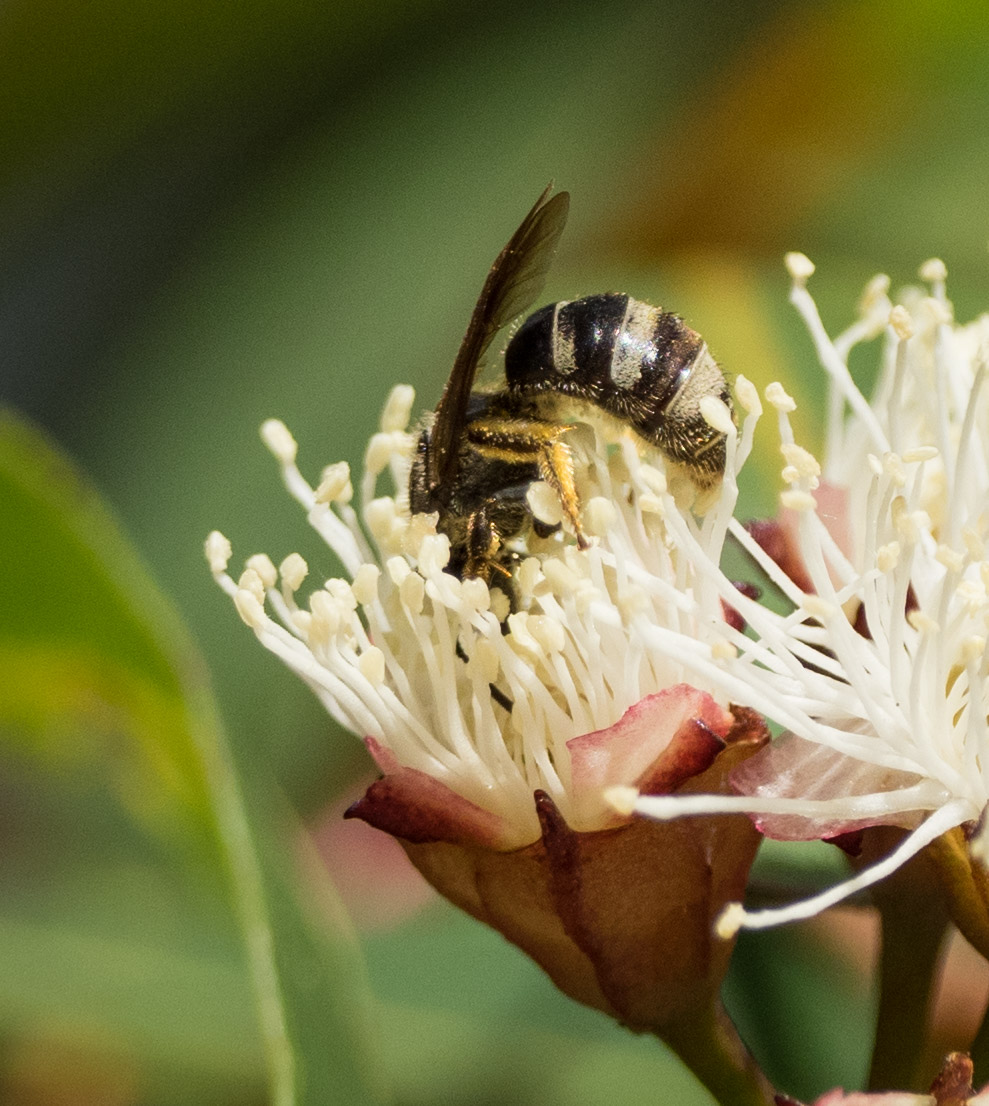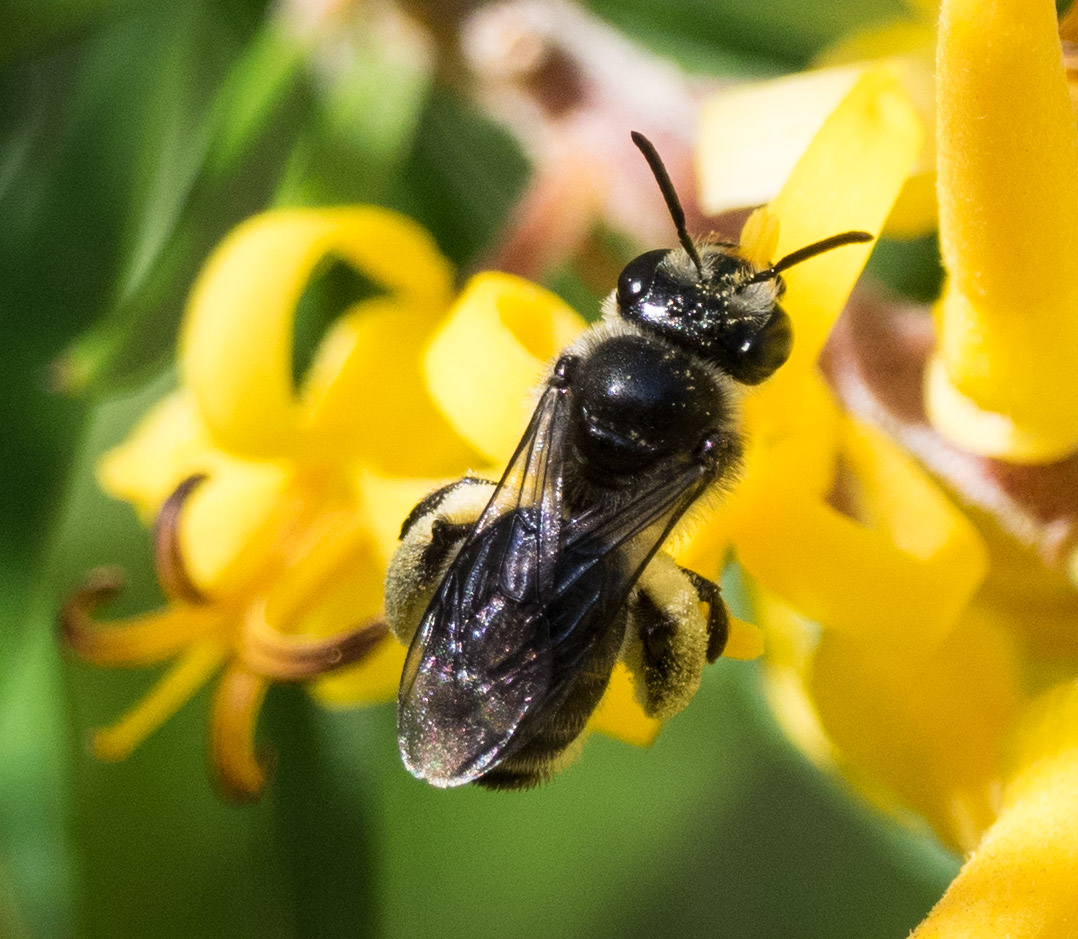Bees and peas
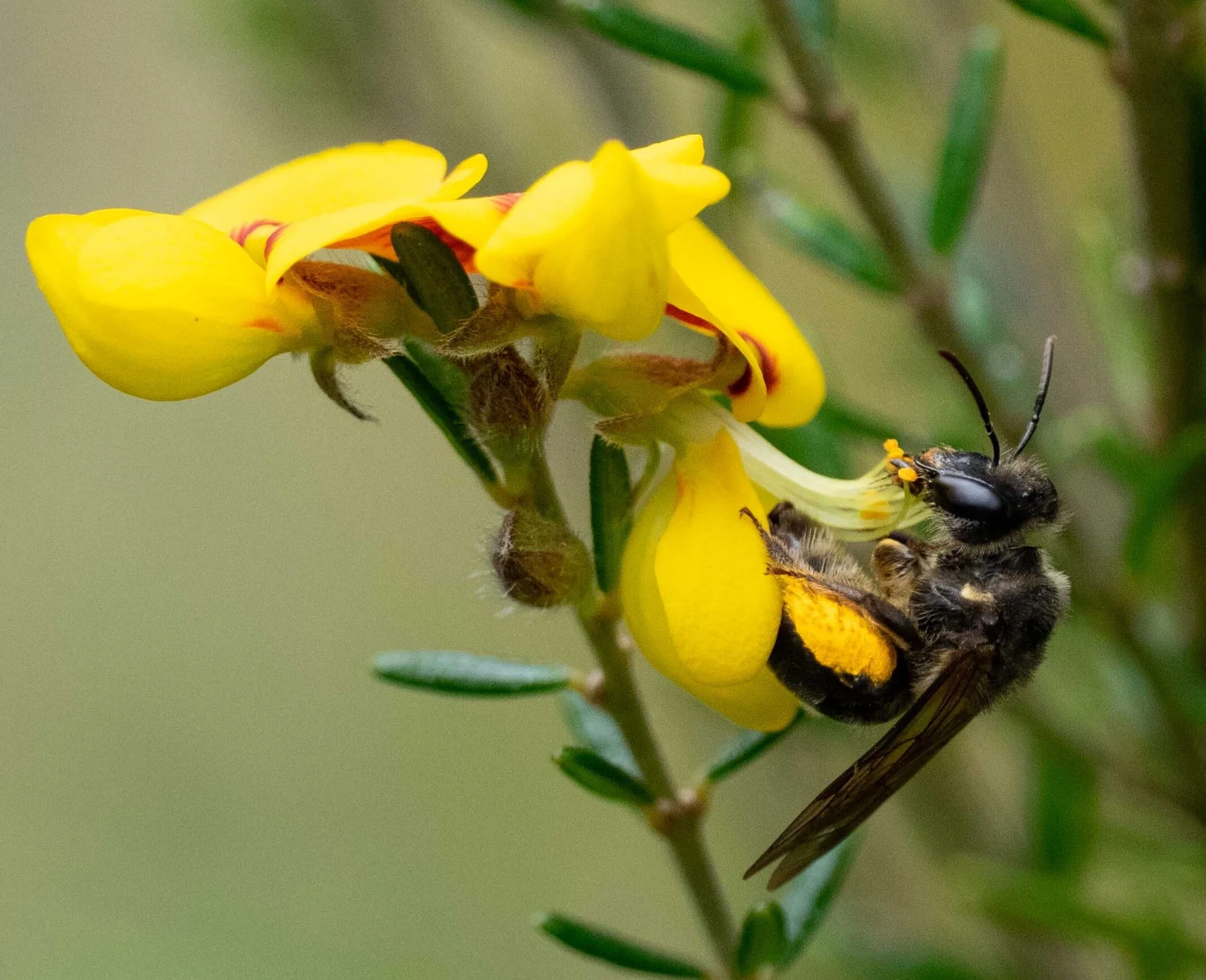
The busiest plants in the forest right now are the Aotus. Despite the drought and regular grazing by hungry wallabies, these hardy bushes have been in bloom for weeks. And bees love them!
Aotus ericoides is endemic to eastern Australia, growing in dry sclerophyll forests and heathland.
So I’ve been spending hours stalking the flowers, watching the usual butterflies and bees come and go, on the lookout for less common visitors.
Each bee I see presents a small challenge. What species is it? What is it doing? Where does she nest? So, with photos in hand, I trawl the literature. Each day I learn a little more about insect behaviour and ecology.
Here’s a glimpse into my recent ramblings.
First, some pea flower anatomy
Different insects behave differently when they land on the Aotus. This has much to do with the shape of the flower.
Pea flowers are complex, and for good reason. Pollen production is not cheap, so the plant benefits if it restricts access to those visitors most likely to deliver it to another flower of the same species.
Pea flowers conceal their anthers within a pocket formed by two petals, the keel (1). The keel is flanked by another pair of petals, the wings (2). The fifth petal, the standard or banner, is expanded and often colourful, serving as an advertising board and nectar directory (3).
To expose the fresh anthers of Aotus flowers, an insect needs both strength and skill (ref. 1). It must have the strength necessary to depress the wings and keel, and it must press in just the right place to trigger the flower to open.
Aotus flowers are small, but many bees are smaller still! And bee strength does correlate with weight (ref. 1).
This tiny bee didn’t stay long, probably unable to access either the nectar or pollen.
An open flower, with the keel depressed, provides access to the deep well of nectar. This is often the insect’s primary goal, but in pushing down on the keel it also becomes dusted with pollen from the exposed anthers.
Of course, many insects simply cheat the system. Butterflies seem particularly skilled at probing for nectar while remaining well clear of the pollen.
The long proboscis of a butterfly can simply slip into the flower without any need to push on the keel.
Now, back to the bees …
A common generalist
Exoneura are perhaps our most numerous bees, from early Spring and Autumn. (I don’t count feral honey bees, which seem to outnumber native species wherever there are flowers!)
The genus includes more than 60 species, all endemic to Australia and concentrated in southern temperate regions.
I don’t know what species we have here, nor how many different species. I do get the impression there are several, based on the variation in size.
The red abdomen, flattened at the end, is enough to convince me that this is an Exoneura species.
Exoneura visit a wide variety of flowers … including Aotus.
Female bias
Most of the Exoneura we see are females – they have hairy back legs for carrying pollen.
Exoneura have a highly skewed sex ration. Only 1 in about 15 larvae develop as males (ref. 2).
Social lives
Many species of Exoneura nest colonially. While they don’t have distinct castes (Queens and workers), a nest can include two or more adult females. They may be related, with the daughters remaining at the nest to help raise their siblings. And unrelated females may share a nest, assisting with the feeding, grooming and guarding of one another’s young (ref. 3).
Exoneura and their near relatives … collectively, the allodapines … display a wide range of social behaviours, and this aspect of their biology has been well studied (ref. 2).
Exoneura have a rather stereotypical approach to Aotus. They land on the keel of the flower, straddling it and thereby exposing the stamens. They then gather pollen with their legs while drinking nectar from deep with the flower.
Food deliveries
Many bees and wasps ‘mass provision’ each larva. That is, they create a cell, stock it with food, lay an egg, and seal the cell. Then they do it all again. Exoneura don’t do this. Instead, sibling larvae share a burrow. They are spaced along the wall, attached by hairs or other structures. Females regularly visit with parcels of pollen and nectar (ref. 3).
Wooden homes
One of the major threats to native bees is loss of nest sites (ref. 4). For example, Exoneura need pithy plant stems in which to burrow, or pre-existing burrows in woody stems. There is a logic to the design of those bee hotels, after all!
Although we’ve yet to track down our local Exoneura nest sites, there are many options for them here in the forest. Persistent Xanthorrhoea spikes seem an obvious choice, as do our small patches of Gahnia and Juncus. Perhaps even more likely are vacated beetle and moth tunnels in the numerous senescing wattles.
But I really need to spend more time searching.
What to look for? Bees coming and going from likely sites. Or little red ‘plugs’ capping off perfectly round holes. Guarding females are known to block the opening to their burrow with the flattened end of their abdomens. I will be looking!
A pea specialist
Occasionally I see a bee that is completely unfamiliar. I hold my breath and try to get as many shots as I can. Then it’s time to see if I can work out who it is.
A hylaeine bee, with the typical wasp-like appearance of this group.
A few weeks ago, as I watched the Aotus visitors, this strikingly shiny, black and yellow bee appeared.
After some digging in the literature, I came up with a tentative ID.
Hylaeus (Planihylaeus) daviesiae
And the colouration confirms that it’s the male of the species.
It was very rewarding to have expert support for my suggestion. My thanks to Michael Batley.
As I watched, the medium sized bee clambered about the flowers for a while, granting me photos from various angles. I’d not seen it before, nor since.
He belongs to the family Colletidae, subfamily Hylaeinae. This is a large subfamily, with some 200 Australian species. The bees are almost hairless - hence the shiny appearance. Females transport pollen by swallowing it, and both sexes can look very much like wasps.
This particular species was first named in 1981, based on a specimen collected on Black Mountain in Canberra. It is reported to specialise in feeding on pea flowers, hence the name H. daviesiae (ref. 5). Daviesia is a genus of shrubs with flowers very like Aotus.
Hylaeus (Planihylaeus) daviesiae on Aotus ericoides, 13th October 2019
He did briefly probe for nectar, but mostly he simply perched on the flowers. Makes sense. He doesn’t need to collect pollen - females do that. He just needs to find a mate. And hanging about their favoured food plant seems a very good strategy.
Solitary lodgers
Hylaeine bees nest in pre-existing holes, including hollow stems, wood borer holes, and the abandoned ground tunnels of wasps and other bees. Hence they are sometimes called ‘lodger’ bees.
Unlike Exoneura, hylaeine females nest alone and each larvae is provided with enough food to see it through development in one hit. The chamber is lined and sealed with waterproof material secreted by the females salivary glands. Hence the other common name for these bees … ‘membrane bees’.
A second pea specialist
This hairy Leioproctus is rather large compared to the Exoneura and Hylaeus above. At first glance she even looks a bit like a honey bee. That is until you actually compare the two directly!
It’s not just size and colour that distinguish them. The most obvious difference is in how they package the pollen for transport. The native bee (Leioproctus) carries it as a rather loose load along the length of her lower leg (tibia). In contrast, the honey bee (Apis mellifera) has a discrete, solid, waxy-looking mass.
Anyway, enough of the rather boofy honey bees and back to the intriguing natives ...
As I watched the Leioproctus on the Aotus, I was struck by the way she manipulated the flowers. Pressing down on the wing petals, she exposed the stamens. She used her mouthparts as well as her underside to rub pollen from the anthers. It looked a very deliberate manoeuvre. She seemed particularly skilled at harvesting the hard-to-get pollen. Perhaps she specialises on pea flowers. Perhaps.
Many Leioproctus species are indeed specialists, adapted for feeding on particular plant groups. Last year I watched Leioproctus stripping the pollen from Persoonia flowers, day after day, the same procedure each time (here’s a link to that earlier story). Probably a different species of Leioproctus. There are many!
Like all the other Aotus visitors, she was also taking advantage of the nectar on offer. Although technically a ‘short-tongued’ bee, she seemed to succeed by depressing the keel and pushing deep into the flower. Again, it’s all in the technique.
Butterflies are opportunists
The Aotus flowers attract insects of all types. Some, like the Leioproctus, may serve to pollinate the plants. Others simply tap into the flowers’ copious nectar … including all six butterfly species below!
Pea mimics
Dotted among the sedges and Aotus are the Tiger Orchids. And they look suspiciously like the Aotus flowers!
Diuris sulphurea flower here from late October, into November.
In fact, I overlooked one lone orchid for several days, surrounded as it was by dozens of pea blooms of similar colour and shape.
Diuris sulphurea are small orchids. The ear-like petals are similar in size to Aotus ericoides flowers.
Diuris does indeed employ mimicry as a means of attracting pollinators. This has been demonstrated for a number of Diuris species, and for a range of bees and wasps (e.g. ref. 6,7).
I have noticed a few insects being drawn to the orchids. Hover flies, butterflies, flower wasps …
Today I even spotted a butterfly probing for nectar! Typically Diuris flowers produce no nectar, That’s the whole basis of the mimicry … to trick insects into visiting without the expense of providing a reward.
However, it is possible that this Heath Blue was actually in luck. It has been discovered that some Diuris sulphurea flowers do indeed make a small amount of nectar (ref. 7)!
This Dull Heath Blue (Neolucia mathewi) spent considerable time probing deep into the orchid.
But what about bees, the supposed targets of the deception?
I’ve yet to see a bee on the Diuris. Perhaps this just reflects my preoccupation with the Aotus. I need to spend more time orchid-watching.
References
Cordoba, S.A. & Cocucci, A.A. 2011. Flower power: its association with bee power and floral functional morphology in papilionate legumes. Annals of Botany, 108: 919–931.
Tierney, S.M., Smith, J.A., Chenoweth, L. & Schwarz, M.P. 2008. Phylogenetics of allodapine bees: a review of social evolution, parasitism and biogeography. Apidologie 39, 3-15.
Houston, T. 2018. A Guide to Native Bees. CSIRO Publishing.
Batley, M. & Hogendoorn, K. 2009. Diversity and conservation status of native Australian bees. Apidologie 40, 347–354.
Houston, T.F. 1981. A revision of the Australian hylaeine bees (Hymenoptera; Colletidae) II. Australian Journal of Zoology, Supplementary Series (1981) 80, 1-128.
Scaccabarozzi, D., Cozzolino, S., Gussetti, L., Galimberti, A., Milne, L., Dixon, K.W. & Phillips, R.D. 2018. Masquerading as pea plants: behavioural and morphological evidence for mimicry of multiple models in an Australian orchid. Annals of Botany, 122, 1061–1073.
Indsto, J.O. 2009. Pollination ecology and molecular systematics of Diuris (Orchidaceae). University of Wollongong Thesis Collections, University of Wollongong

























